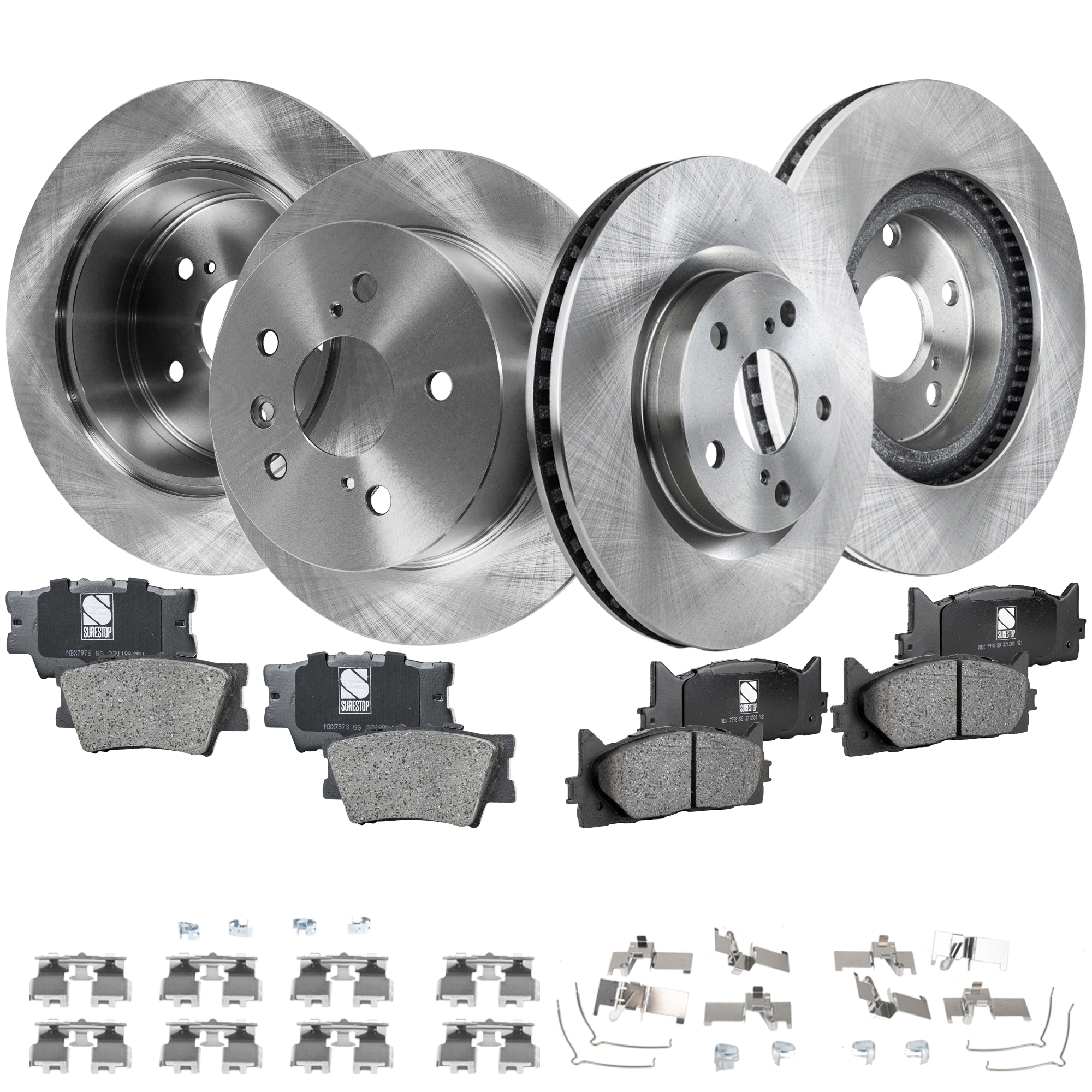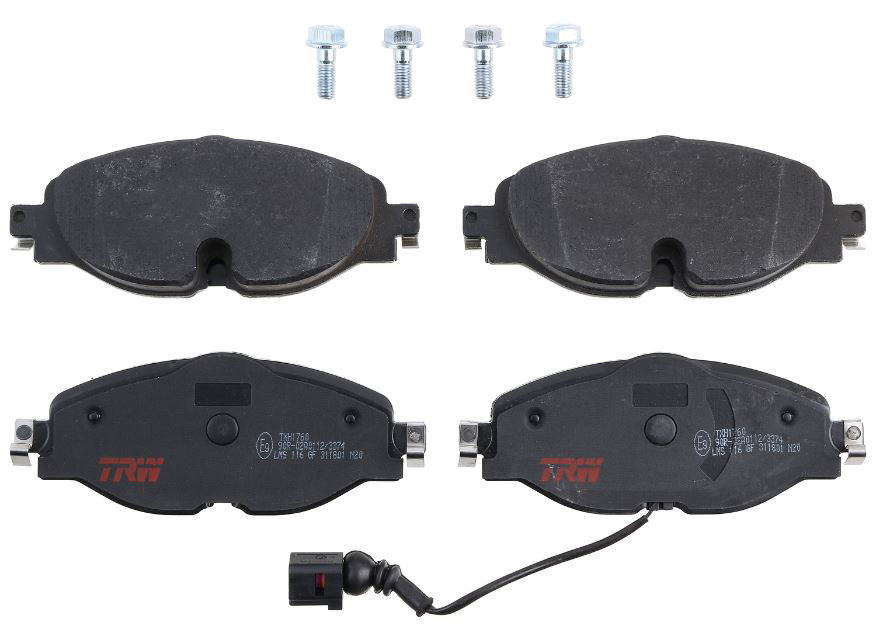Brake pads are a crucial yet frequently neglected part of your car. All too often, you’ll hear a vehicle that makes a horrendous grinding noise while braking. That sound usually means your brake pads’ metal backing plates are digging into your rotors—and that’s bad news.
During my 14-plus years in the auto industry, I’ve seen some brake pads that were worn to the point that their backing plates were nearly fused to the rotors. I’ve also seen some oddball stuff, including a dead mouse that was caught between a rotor and a brake pad (my heart went out to that little guy).
But I digress. Getting back to the topic at hand: You don’t want to keep driving with worn brake pads until you’re that person with the screeching car. It’s a good idea to visually inspect your brakes (or have your mechanic check them) on a regular basis. That way, you can catch signs of wear early on.
If, however, you haven’t been that proactive, we’re here to point out a few symptoms that may indicate your pads are due for replacement.

You May Have Faulty Brake Pads If…
Are you concerned you may have worn or faulty brake pads? If your car is exhibiting one or more of the following symptoms, you may be right:
- Grinding or Squealing Noises While Braking: A hideous grinding noise while braking is a common sign your brake pads are toast. This sound usually indicates that your brake pads’ metal backing plates are making contact with your rotors.
You may also hear a high-pitched squealing or grinding noise that indicates your metal brake pad wear indicators are digging into your rotors. The sound may be heard only when braking, or it may be audible whenever the car is in motion.
Also, sometimes the friction material of low-quality brake pads can cause a squealing noise.
- Visual Wear of Pad Friction Surfaces: If your brake pads are visibly worn, it’s time to swap them out. Most professionals suggest replacement when the friction lining is less than 4mm thick at any point (some recommend replacement starting at 6mm).When there’s less than 3mm, the pads should be replaced immediately.

- Clunking Sound While Braking: Although rather rare, pads that are worn unevenly can cause a clunking noise while braking. The high and low spots of the pad surface bouncing up and down on the rotor cause this sound.
- Abnormal Brake Pedal Feel: This one is rather rare as well, especially for modern cars. In some instances, however, worn brake pads can cause excessive clearance between the pads and rotors, resulting in a low brake pedal. Pads that are glazed or contaminated can also cause a low or grabby brake pedal.
- Vibration or Pulsation While Braking: A vibration or pulsating sensation while braking is usually attributed to warped rotors. But sometimes, unevenly worn pads can cause the issue as well.
- Pulling to One Side While Braking: Pads that are glazed, or contaminated with fluids or grease, can cause the car to pull to one side while braking.
- Low Brake Fluid Level: As the pads wear, the brake caliper piston has to extend further for the pads to make contact with the rotors. In this situation, because the caliper is activated by brake fluid, the fluid level drops.
- Illuminated Warning Indicators: There are a couple of warning lights that may pop up on the dash if your pads are worn. The first is the red brake warning light, which comes on when the brake fluid level drops beyond a certain point. Cars with brake pad sensors will have a separate brake wear indicator that shows up on the instrument panel.

What Do Brake Pads Do?
There are two different types of braking systems: disc and drum. Disc brake systems rely on brake pads and disc-shaped brake rotors for stopping power. All modern cars have front disc brakes and many have disc brakes at all four wheels.
Brake pad operation is straightforward. When you press the brake pedal, pressurized hydraulic fluid flows from the master cylinder and acts on the brake calipers. Each of the brake calipers contains a set of brake pads that squeeze against the brake rotor, creating the friction needed to stop your car.
There are also three basic types of brake pads: organic, semi-metallic, and ceramic. Each is classified based on the type of friction lining used. Typically, ceramic pads are the most costly, but they also make little noise and produce minimal dust.
What to Do If You Think You Have Faulty Brake Pads
We’re talking about your brakes here—and you don’t want to mess with your brakes. Worn pads can reduce stopping ability and compromise vehicle safety. If you suspect you have bad brake pads, diagnose and repair the problem right away.
Most professionals recommend either resurfacing (if possible) or replacing the rotors when you swap out your brake pads. It’s best to replace these components together so they mesh from the beginning, promoting even wear and optimal performance. Brake pads are also serviced in pairs (two pads per wheel; four pads per axle).
The good news is that brake pad replacement’s one of the easier repairs and, therefore, is usually pretty affordable. So, don’t put it off any longer.
Watch these videos to understand how to replace your front and rear brake pads:
Finding New Brake Pads for Your Vehicle
If your vehicle’s brake pads are too worn out or damaged to function properly, it’s not a good idea to drive your vehicle until it’s replaced. They could reduce your ride’s braking performance, increasing the risk of getting into accidents. Luckily, you can get top-notch replacements in no time when you shop online at CarParts.com.
Sourced from the top names in the industry, all our brake pads passed the highest quality control standards from industry experts. To start shopping, fill out vehicle selector and change the search filters based on your needs. If you have any questions, our friendly customer service team is available 24/7 through our toll-free hotline. Don’t hesitate to get in touch with us.
If you’re on a tight budget, don’t worry. Our parts are available at competitive prices. Order new brake pads now, and we’ll deliver your product straight to your doorstep in as fast as two business days.
Check out our catalog and shop now!
Shop this Project



Any information provided on this Website is for informational purposes only and is not intended to replace consultation with a professional mechanic. The accuracy and timeliness of the information may change from the time of publication.



















